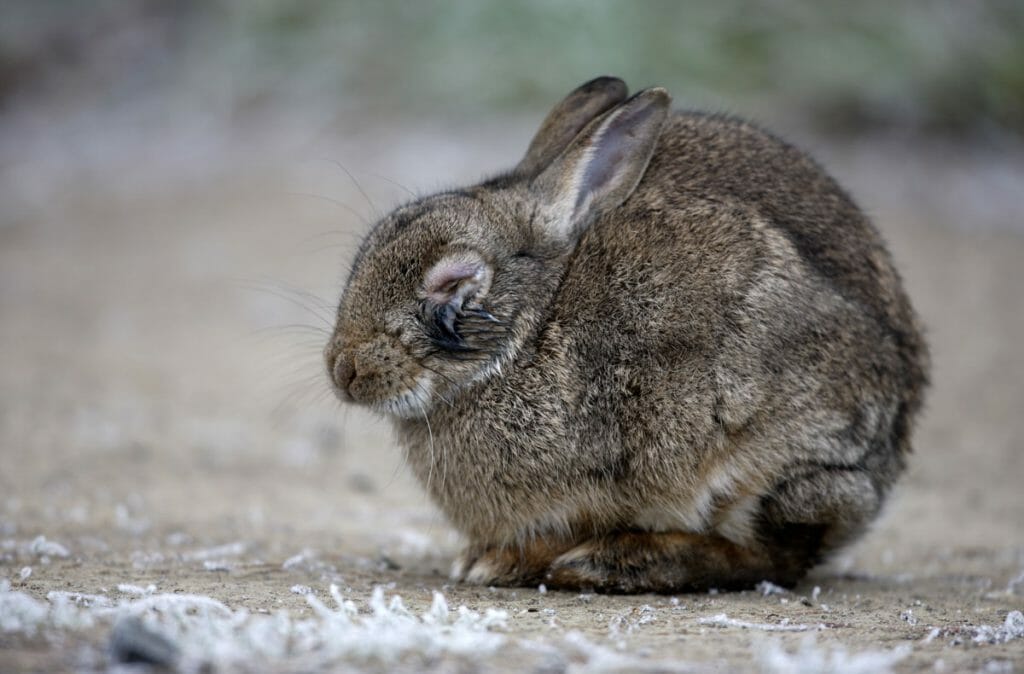Rabbit Hemorrhagic Disease (RHD) is a highly contagious, lethal virus caused by a calicivirus. It was first observed in China in 1984 and has since spread to Mexico, continental Europe, Israel, the United Kingdom, Australia and New Zealand.
Since 2010, a variant called RHD2 strikes. The symptoms are more discreet but, despite a slower progression of the disease, the outcome is the same. It even strikes rabbits younger than its classic form, as early as two months of age.
Very resistant, the calicivirus remains viable in the environment for 105 days at room temperature and for 42 days minimum in a surviving carrier rabbit . It is even resistant to freezing.
The symptoms of RHD
Symptoms may include:
- loss of appetite;
- lethargy;
- high fever;
- spasms;
- nose, mouth, and rectal bleeding;
- sudden death…
Sometimes, however, rabbits die, without having had any of these symptoms.
The incubation period for this disease is very short, death can occur within 48 hours.
How is RHD transmitted?
The highly contagious RHD can be spread by:
- contact with contaminated objects: clothing, shoes, pillows…
- direct contact of a rabbit with an infected rabbit or the feces of an infected rabbit
- insects, birds, and animals such as rodents are known to spread the virus by acting as indirect hosts
- humans can transmit the virus to their rabbits if they have been in contact with infected rabbits or with objects contaminated with the virus, including the feces of an infected rabbit.
What are the treatments for RHD?
Take a few precautions on a daily basis. If you hear about an outbreak that is going on, keep your rabbit indoors until things calm down. Wash your hands thoroughly, as well as any clothes – and shoes – you were wearing if you’ve just returned from places where other rabbits – or people in contact with rabbits – may have been.
Make sure the hay you give him comes from a healthy place.
Any new rabbit should be put in quarantine.
Protect your rabbit from fleas and ticks that he may “pick up” on his way out, or that are transmitted to him by other pets in the house, dogs or cats with access to the outdoors.
There is no known treatment for RHD, neither for its classic version, nor for its variant. The only solution is to vaccinate your rabbit. Get in touch with your veterinarian.
What steps should be taken after a death to disinfect everything?
When the rabbit dies, its body remains contaminated for several months. You are not prohibited from burying it, but you are taking risks of contamination, in case a wild animal digs it up. For example, foxes living around villages sometimes dig up recently buried domestic cats.
It is best to cremate your rabbit. All his belongings and his environment must be scrupulously cleaned and disinfected with bleach; cushions, blankets and other textiles must be boiled in a washing machine; if you have any food or hay left, you must throw it all away.
Even if you don’t have to, it’s important to tell your veterinarian, who can in turn tell his other rabbit-owning clients. This is one of the factors that will help contain the epidemic.
Don’t take the risk of your rabbit dying from RHD when the vaccine can effectively protect him.
Share this information with as many rabbit owners as possible. This will help to reduce the number of epidemics and even eradicate them permanently, as was the case for rabies in France.
Translated from French by Margaux

 Food
Food Essentials
Essentials Toys
Toys Accessories
Accessories Goodies
Goodies

